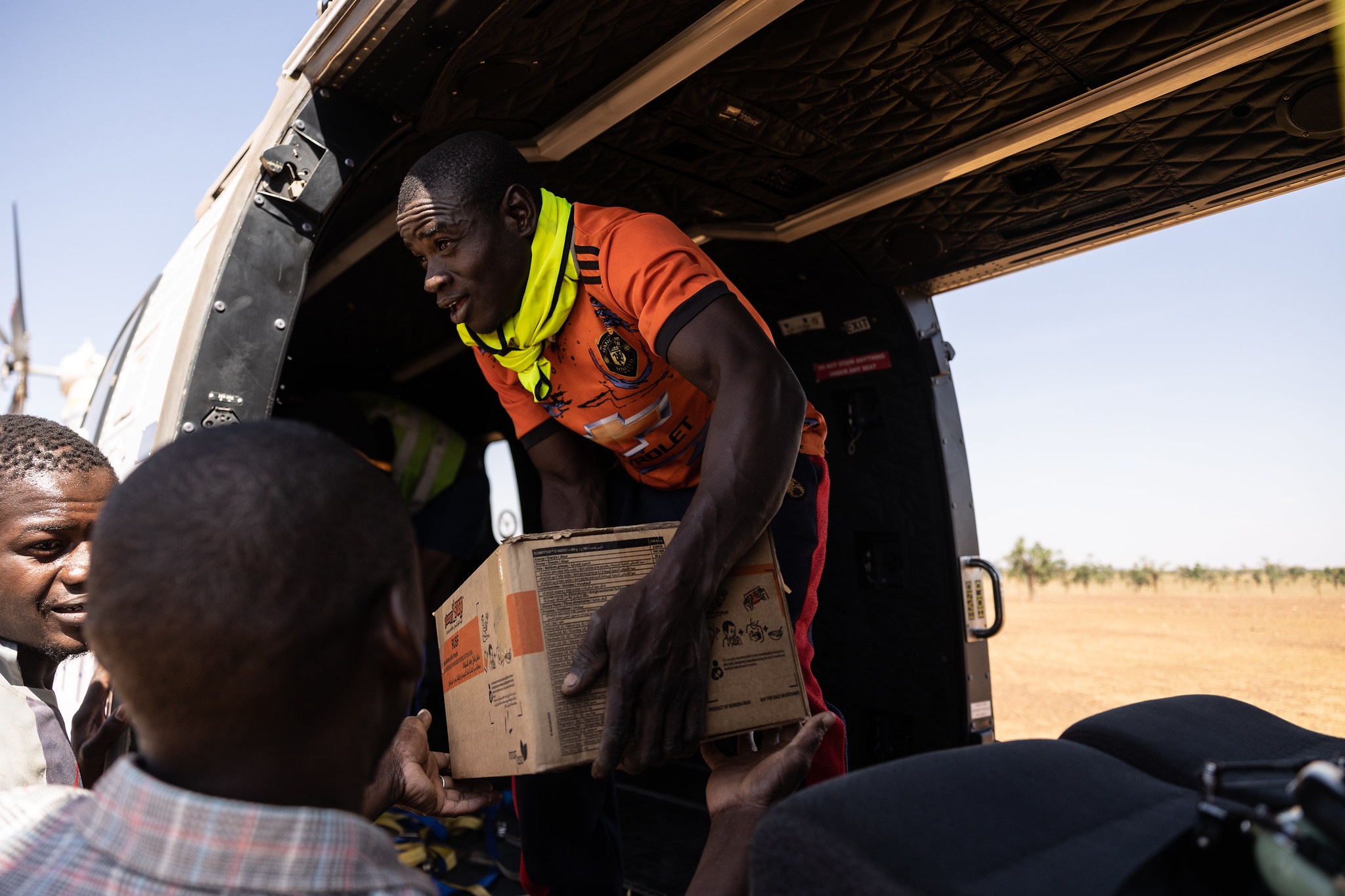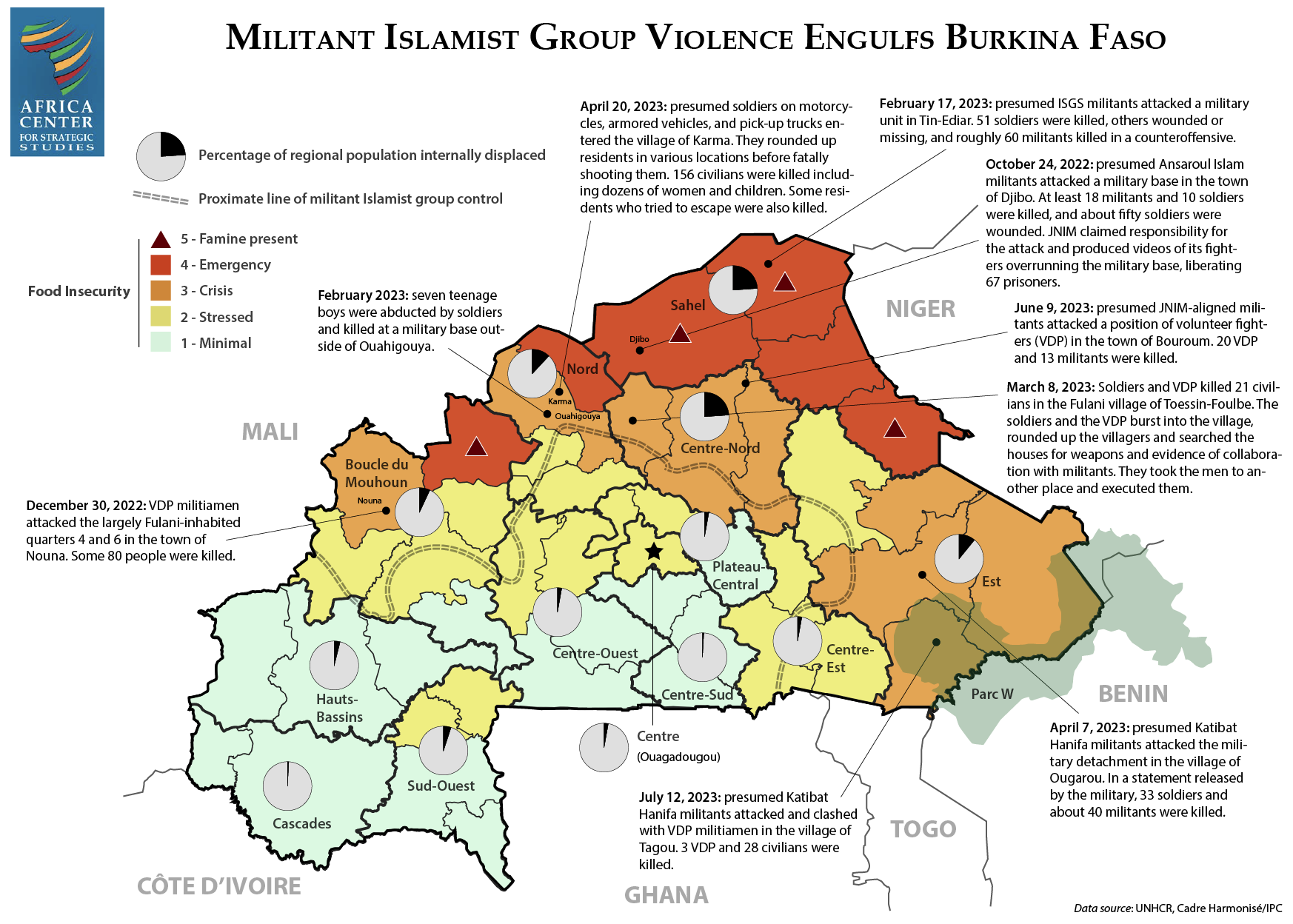Click here for printable PDF maps
A Dire Situation
Originating in Mali, militant Islamist groups threaten an increasing number of communities throughout Burkina Faso, shifting the epicenter of violence in the Sahel.
Military coups in January and September 2022 have exacerbated the situation. Since the coups, the number of people killed by militant Islamist violence has nearly tripled compared to the 18 months before the January 2022 coup. This violence, coupled with the geographic spread of extremist activities effectively surrounding Ouagadougou, puts Burkina Faso more than ever at the brink of collapse.
- At the current trajectory, an estimated 8,600 people will be killed in violence linked to militant Islamist groups this year. This represents a 137-percent increase from the previous year, which saw 3,627 fatalities.
- The surge in fatalities accompanies a rise in the lethality of militant Islamist group attacks. In 2023, each violent event is linked to five fatalities, on average. This is a dramatic escalation from the previous year, which saw 2.4 fatalities per violent event.
- Violence attributed to militant Islamist groups has spread significantly, encompassing 6,975 km2 of territory compared to 4,775 km2 prior to the first military coup in 2022—an increase of 46 percent. While Ouagadougou enjoys a defensive advantage from its location on a highland plateau, this spread threatens to sever the capital from the main transit lines for commercial trade.
- Katibat Hanifa, a subgroup of the JNIM coalition of militant Islamist groups, has appeared as the primary militant group operating in eastern Burkina Faso. While relatively little is known about this emerging group, this is a strategically important region that connects Sahelian Africa to its coastal neighbors. It also encompasses the major commercial routes from the ports in Togo and Benin to Burkina Faso and Niger. Meanwhile, other JNIM elements have begun to expand westward along the border with Ghana further threatening coastal West African countries. The Islamic State of the Greater Sahara (ISGS), and the JNIM-affiliated Macina Liberation Front and Ansaroul Islam also remain active in northern Burkina Faso.
“At least 800,000 people are effectively living under a militant Islamist group siege.”
- At least 800,000 people in more than two dozen towns have already been cut off from the major thoroughfares and are effectively living under a militant Islamist group siege. A sustained blockade of Ouagadougou would have devastating effects for the entire country.
- Roughly 1 in 10 Burkinabè citizens—more than 2.1 million people—have been forcibly displaced from their homes due to the insecurity. Approximately 95 percent of the displaced have remained in Burkina Faso, but with the insecurity spreading across the country, neighboring countries will likely witness increased numbers of refugees.
- As an illustration of the instability, violence has shuttered 6,134 schools in Burkina Faso. This is a 44-percent increase since the previous year when 4,258 schools were closed. Roughly 1 in 4 schools in the country are now not operating. These school closures have impacted over 1 million students as well as 31,077 teachers.
Violence against Civilians has Surged under Junta Rule
The civilian population has come under increasing attack by militant Islamist groups since the country has fallen under the grip of the military junta.
- During the 18 months since the first military coup, the number of civilians killed by militant Islamist groups increased by 165 percent compared to the same period prior to the coup. More than 1,700 civilians are projected to be killed by militant Islamist group violence in 2023.
“10 of 11 regions affected by militant Islamist violence against civilians are projected to see at least double the number of civilians killed in 2023.”
- Nearly two-thirds of the civilians killed by militant Islamist groups lost their lives in Burkina Faso’s regions bordering Mali. Ten of eleven regions affected by militant Islamist violence against civilians are projected to see at least double the number of civilians killed in 2023. Five of these regions—Sahel, Boucle du Mouhoun, Est, Centre-Nord, and Nord—are projected to surpass 200 civilians killed by militant Islamist groups.
- Civilians have also been subject to increased attacks by the military and their allied militias. The military has been credibly accused of various instances of human rights abuses and has been implicated in the extrajudicial killings of children by human rights organizations and journalists, including a military-linked massacre of at least 156 civilians in Karma.
- Starting in October 2022, the military rapidly enrolled tens of thousands of militia members, known as Volontaires pour la défense de la patrie (VDP). In December 2022, VDP militia members allegedly massacred at least 80 civilians in the town of Nouna in retaliation for an attack by militant Islamists on a local gendarmerie station.
- The number of civilians killed by the military or VDP since the January 2022 coup has more than tripled, to 762 fatalities, compared to the 18 months before the coup. Extrajudicial killings have grown under the junta led by Captain Ibrahim Traore, who seized power in September 2022.
- In response to media coverage of these abuses, the junta has expelled international journalists and banned local media including Radio Omega. Similarly, civil society activists and political opponents to the junta have been intimidated, threatened, and detained for criticizing the junta. These actions have had a chilling effect on dissent, likely leading to underreporting of the military abuses on the population.
Click to enlarge | Click here for a printable PDF version
Battle for Territorial Control
The locus of militant Islamist group violence in Burkina Faso remains its Sahel region, which abuts the borders of both Mali and Niger. However, Burkina Faso’s Est region, which includes the Burkinabè side of the Parc W complex, also offers safe haven to extremists (and threatens coastal West African countries). Meanwhile, regions in the northwest and west have seen significant increases in militant Islamist group activity in the past year.
“Roughly half of Burkina Faso’s territory is effectively outside of government control.”
- Roughly half of Burkina Faso’s territory is effectively outside of government control. This is particularly the case in the eastern and northeastern territories of the country. In these areas, various militant Islamist groups linked with the JNIM coalition clash with ISGS as the groups vie for control of territory.
- An estimated 3 million Burkinabé are suffering from hunger due to the insecurity. Among those affected, nearly 650,000 individuals are facing extreme hunger (Integrated Acute Food Insecurity Phase Classification 5), meaning people are already starting to die from a lack of food.

The EU Humanitarian Response Capacity (EHRC) delivers supplies as part of a Humanitarian Air Bridge to alleviate the suffering of blockaded towns in Burkina Faso. (Photo: EU 2022)
- The population of the provincial capital Djibo has grown by 600 percent to over 300,000, or roughly the size of Arusha, Tanzania, from the arrival of hundreds of thousands of IDPs.
- Djibo and other urban centers, like Sebba, have been cut off from commercial transit by militant Islamist blockades. Populations under blockade face a growing risk of starvation.
- Other larger urban and administrative centers, including Fada N’Gourma, Ouahigouya, and Kaya are also at risk of being encircled by militant Islamist groups. These urban centers are under enormous strain as more displaced people seek refuge.
- These population centers are also important nodes in Burkina Faso’s transportation network serving as hubs that form the connective arteries to and from the centrally located capital city.
Additional Resources
- Africa Center for Strategic Studies, “African Conflicts Displace Over 40 Million People,” Infographic, August 22, 2023.
- International Crisis Group, “Containing Militancy in West Africa’s Park W,” Report No. 310, January 26, 2023.
- Human Rights Watch, “Burkina Faso: Unlawful Killings, ‘Disappearances’ by the Army,” June 29, 2023.
- Human Rights Watch, “Burkina Faso: Upsurge in Atrocities by Islamist Armed Groups,” June 15, 2023.
- Africa Center for Strategic Studies, “Understanding Burkina Faso’s Latest Coup,” Spotlight, October 28, 2022.
- Africa Center for Strategic Studies, “Conflict Remains the Dominant Driver of Africa’s Spiraling Food Crisis,” Infographic, October 14, 2022.
- Africa Center for Strategic Studies, “Five Zones of Militant Islamist Violence in the Sahel,” Infographic, September 26, 2022.
- Leif Brottem, “The Growing Threat of Violent Extremism in Coastal West Africa,” Spotlight, Africa Center for Strategic Studies, March 15, 2022.
More on: Sahel Security Trends






